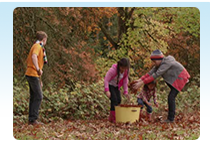
![]()
Wildlife Habitat Maintenance by Season
-
Leaf debris – It may seem like you should clean up the brown, dried plant stems and leaf little, but the hollow stems of plants act as homes for caterpillars, spiders, and insects. Dried seed heads also offer food to birds.
-
Birds have more difficulty finding water in the winter. Add water to your bird bath as needed so birds have a liquid water source.
-
Winterizing – if you haven’t already, bring inside any garden features that may break or crack if they fill with ice or water.
-
Clean up – As temperatures rise, clean up some of the dried, brown plant material from last fall. Clip the old flower stalks close to the ground. You can rake up plant debris on the ground or use it as additional mulch and organic material for the plants.
-
Mowing – Large meadows can be mowed in the spring.
-
Pruning – Shrubs typically need to be pruned right after they bloom. Do not prune flowering shrubs early in the spring or you will clip off the new growth, which will result in a year with no flowers. This means no food for pollinators and no seeds or berries for you to see or for birds to eat. Google your particular shrub to find the best pruning schedule for that species.
-
Weeding – Weed as necessary, but be careful not to pull out small seedlings and sprouts. Sometimes small native plants are hard to differentiate from weeds. Make sure you properly ID your plants before weeding (refer to a planting map if you have one). Most farmers markets in Fairfax County have a Master Gardeners table where you can get help identifying a plant.
-
Watering – As the weather starts getting warmer, water your plants when spring showers aren’t sufficient to keep them hydrated.
-
Mulching – Spread mulch around plants to suppress weed growth, retain moisture, and improve soil nutrients.
-
Signs – Check for any garden signage that may need repair and make sure your plant signs are in the correct location.
-
Watering (the first 3 years) – Young native plants (up to about 3 years old) will need to be watered weekly through the hot stretch from mid-June to mid-September. If you have a summer program at your school, recruit them to help care for the garden. Otherwise, you could have families sign up to adopt the habitat for a week over the summer. If there is a particularly hot streak, you may want to water more than once a week.
-
Watering (established habitats) – After about 3 years, the root systems of the plants are developed enough for the plants to withstand drought. Water during especially hot or dry periods throughout the summer.
-
Check for standing water – Check items that may hold standing water such as garden pots, watering cans, etc. and dump any water they are collecting. Mosquitoes breed in small amounts of standing water, so not allowing water to collect is essential.
-
Refresh bird baths – Bird baths can become a mosquito breeding haven if the water is left for too long. Change the water at least every 5 days to avoid mosquito breeding.
-
Weeding – Check the garden area regularly for weeds and invasive plants. Removing them as you find will make maintaining your habitat easier in the long term. This should be done a couple times a month or so depending on your habitat’s needs.
-
Weeding – Keep clearing your garden of weeds and invasive plants.
-
Leaf debris – It may seem like you should clean up the brown, dried plant material, but the hollow stems provide shelter for caterpillars and other insects. Leaf litter is often home to insects and spiders too, so do not clean it up until early spring. Dried seed heads offer food to birds all winter. They also look beautiful covered in snow.
-
Winterizing rain barrels – To prevent your rain barrel from cracking in the winter, you will need to winterize your rain barrel. Remove any other containers or features that might crack or break if ice forms in them.
**Do not use pesticides in your wildlife habitat. Most pesticides will kill butterflies and other insects you want in your garden.
See the Wildlife Habitat Maintenance Resource Folder for more information on maintaining your wildlife habitat and for a printable version of this page.





